The second bit is that I will be scaling back my involvement in this wonderful bookshop, becoming something of a rarely visiting but tyrannical consultant-like figure as I get the rest of my life in order, and as a result I -- Lydia -- will no longer write most of our blog entries! I weep, dear readers, truly I weep. The hilarious Alan will replace me on a regular basis, so you can look forward to blog entries with less of a Victorian tone and more coherent themes.
No longer writing the blog! Dear readers, it is like an omen or a portent -- something like what's recorded in this Affordable and Interesting little tome:
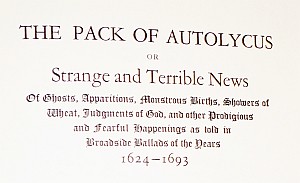
In case you cannot read that Gothic lettering, the tagline of this book reads: "Strange and Terrible News of Ghosts, Apparitions, Monstrous Births, Showers of Wheat, Judgments of God, and other Prodigious and Fearful Happenings as told in Broadside Ballads of the Years 1624-1693". Now I knew that a "broadside" is a term referring to excitable poster-like sheets of paper, splashed about the town; what I did not know is that once upon a time, all broadsides recorded ballads, and were sold for a pittance by musicians. (You can see some images and such from old broadsides at the Bodleian Library's website: click here!) It would seem that this book chronicles a particular collection of broadside ballads (that of Anthony Wood, a medieval gentleman who essentially kept a scrapbook of the things), and that his collection particularly featured tales of strange and marvelous occurrences. For instance, one page has this woodcut:

... accompanied by a rather involved set of verses covering many lands, including:
In Anno sixteene hundred and eighteene,
A blazing Starre was o'er Bohemia seene,
Which for the space of seven and twenty dayes,
Within the sky most fearefully did blaze.
And in Hungaria (as 'tis understood,)
Water was Metamorphos'd into bloud.
In Brunswick-land (within an evening faire,)
Were seene two armies fighting in the aire.
Intrigued? Me too! $12.50, and who knows what you might discover of our supernatural past?!
Supernatural influences are pernicious and subtle. I think that some must have been at work in these Collector's Items:

You see, the Easton Press produces elegantly leather-bound books with gilt detailing and gilt edges; editions that will last a long time, and look nice to boot. In the past I have mostly seen books chronicling American presidents, or famous classic books, from the Easton Press. But it seems that some odd supernatural influence has caused them to branch out ... into things like "New Yorker" cartoons! (I see from their site that they are also selling the classy How to Be A Betty: Unleashing Your Inner Boop... what is the world coming to?) At any rate, here lie collections of "New Yorker" comics (as hilarious as ever) on the subjects of Doctors, Lawyers and Business -- $75.00 apiece. The gilt detailing on these particular Easton editions features the famous New Yorker monocle theme: gilted doctor with monocle, lawyer with monocle, and businessman with monocle. And if you get the Business one, you will gain one of the most legendary "New Yorker" cartoons ever:
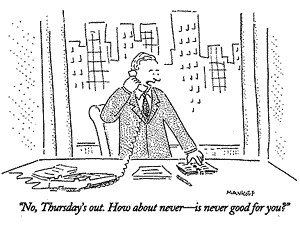
I wish all my comic books were bound in elegant leather!
But my Favorite this week, and possibly for all time, is not comics or strange phenomena or leather; it's the entire incredible Asian Studies collection that we're getting in right now.
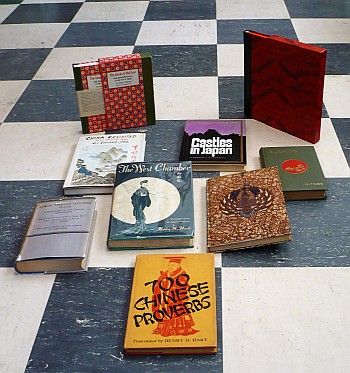
We've only just begun processing these books, and they are absolutely marvelous! We have had to dramatically expand our sections on Miscellaneous Asian Countries, China, Chinese Art, Japan, Japanese Art, India / Pakistan, Eastern Religion / Philosophy, and Middle East / Islam -- just to fit all the remarkable books that we're getting. And there's more to come! Our Asian Studies section will be completely incredible for some time, gentle readers, I assure you -- here you see a mere sampling of the material we worked with today. First we have some quite scholarly titles on subjects like Asian literature, psychological theories, education, and all manner of more specific subjects -- such as the above-pictured book on Japanese castles, which I might just kill for (or buy for $10.00). Then there's various kinds of art in translation; Three Tibetan Mystery Plays: As Performed in the Tibetan Monasteries is one of the most obscure and fascinating examples ($35.00):
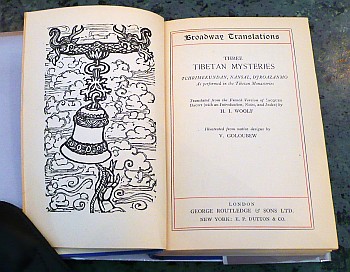
And then there's some random items, such as this charming little collection of translated Chinese proverbs:
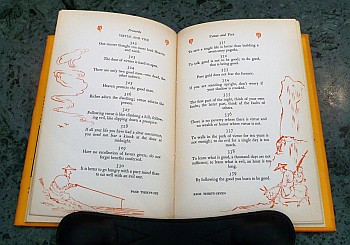
$12.50 gets you all of the following and more!:
* He who only comes from upstairs is a guest.
* Don't ask a guest if you may kill a fowl for him.
* He is truly a superior man who can watch a chess game in silence.
* Eggs must not quarrel with stones.
* A divided orange tastes just as good.
I am thinking that I may be unable to leave the store. I may simply sit in the Asian Studies area and read. For the rest of my life. You mark my words! My beard will grow long and my sight will dim before I can tear myself away from these books ... probably.
Thank you for being an appreciative audience, my dearest readers. I will return perhaps as a guest star, and see you all around!













 .
. 





